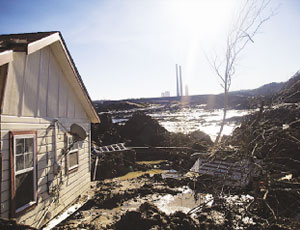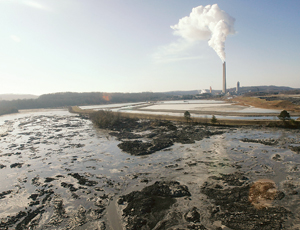Cleanup of the worst spill of its kind the history of the United States continues this week in east Tennessee, where an earthen retention wall at the Tennessee Valley Authority’s Kingston coal plant failed on Dec. 22 and covered 300 acres with 5.4 million cubic yards and water—or more than one billion gallons—of a sludge-like byproduct of coal combustion called fly ash.


The sludge came from a 40-acre waste pond, one of three at TVA’s Kingston Fossil Plant, a coal-fired plant about 40 miles west of Knoxville in Roane County, Tenn., near the Clinch, Emory and Tennessee rivers. No one was seriously injured, but the initial spill, called “a tidal wave” by the U.S. Environmental Protection Agency, destroyed three homes and ruptured a major gas line.
The cause of the failure is unknown, but TVA officials say that rain and freezing temperatures may have contributed. “We’ve got a root cause investigation team, but ’most all of our efforts are trying to restore area,” says TVA spokesman John Moulton. A TVA inspection conducted last year found “wet spots,” indicating minor leaking but “no significant problems found that indicated that the dikes were unstable to the point of failure,” he says.
But Jack Sparado, a former national mine safety and health engineer, says that the inspection report indicates serious problems that TVA should have addressed. He conducted the engineering analysis of a similar, 300-million-gal, coal slurry spill in Martin County, Ky., in 2000 and wrote the engineering report of the Buffalo Creek, W.Va., coal slurry spill that killed more than 100 people in 1972.
Sparado says the dike has been failing since 2003 because of foundation piping, or internal erosion. There had been two minor blowouts in recent years and TVA noted seepage. The agency took corrective measures, Sparado says, but the only solution would have been to drain the reservoir and reconstruct the dam. “It was completely irresponsible of TVA to allow the dam to continue to be used when they knew of these previous problems,” he says. “They should have done a complete stability analysis of whole dam and essentially reconstructed it. It certainly should have been engineered better than it was.”
Ronald Hall, Kingston plant manager, says that other than the blowouts, TVA had “no indication or concerns leading up to the event.”
On Dec. 29, TVA Inspector General Richard Moore announced that his office is conducting a review of the cause, response and what TVA can do to prevent similar spills at its other facilities. Kingston is one of TVA’s largest coal plants, with nine units, with a capacity of 1.7 gigawatts. The plant consumes 14,000 tons of coal daily, producing enough electricity to supply about 670,000 homes. Two units are continuing operation.
Kingston’s coal-burn produces about 2.2 million tons of byproduct a year from emissions-controls equipment. The fly ash, which includes heavy metals such as arsenic, lead, barium, chromium and manganese, is placed into a settling pond. Sludge is then dredged and placed in an on-site landfill, according to a spokeswoman for the Tennessee Dept. of Environmental Control. TDEC issued the permits for the plant’s landfill and water discharge systems.
The fly ash pile, towering 55 ft above the retention pond’s water level prior to the failure, was within permit levels, TVA says. EPA classifies fly ash as a solid, rather than a hazardous waste.
Environmentalists and others say the material is cancer-causing and dangerous. “It is toxic regardless of what TVA says,” Sparado says.
TVA will not continue to use the wet ponds at the Kingston plant. “We’re going to go to dry stacking or offsite storage,” Hall says.
About 55% of coal plants dry-stack coal ash at 600 U.S. sites, says David Goss, executive director of the Aurora, Colo.-based American Coal Ash Association that promotes beneficial use of coal ash. In dry storage, the ash is mixed with about 20% water and placed in a landfill.
In older plants, like Kingston—completed in 1955—wet storage was the only option, Goss says.
Almost 70 pieces of heavy machinery, including bulldozers, skimmer booms and vacuum trucks and amphibious track hoes, and more than 150 people are working to clean up the spill, Hall says. Some of the dry material is being bulldozed back into the containment area, while the sludge is being put elsewhere to dewater. TVA is using its own heavy equipment division and has contracted out to numerous local contractors, Hall says.
Near the plant, crews are building a 500-ft-long subsurface weir in the Emory River to catch any remaining debris, while booms skim silica. Nearby waterways will be dredged. A 2,000-ft-long wall, or weir, is being built to contain the dry ash that will be dredged from the Emory River, Hall says.
By Dec. 30, crews had cleared debris from about 2,600 ft of a main access road and 1,200 ft of the railroad tracks to the plant, Hall says. He says it will take about three weeks to clear the road. EPA, the Tennessee Dept. of Environmental Control and TVA are conducting regular water and air testing. The EPA reported elevated levels of arsenic and heavy metals in the water and warned that people should not drink untreated river water. On Monday, the three agencies also said that direct contact with the fly ash should be avoided and children and pets should be kept away from the affected area. Airborne particles will become a growing concern as the sludge dries.
Sparado says the initial Martin County cleanup took six months to a year, and residual material remains in the soil and sediment surrounding the spill. TVA has no cost estimates on the damage or what the cleanup will cost.

Post a comment to this article
Report Abusive Comment